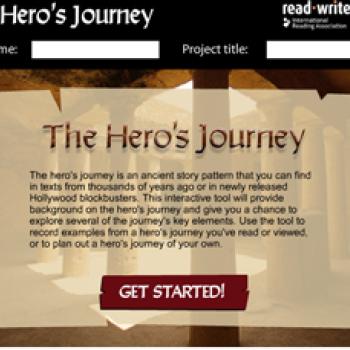Preparing for the Journey: An Introduction to the Hero Myth

- Preview |
- Standards |
- Resources & Preparation |
- Instructional Plan |
- Related Resources |
- Comments
Overview
Through class discussion and reading picture books, students explore the literary concept of a hero and the elements of a hero's journey. Unsing an online tool, students will identify the central elements of a hero's journey in a simple text. After analyzing the picture books and presenting their findings to the class, students are encouraged to embark on the study of a more substantial text.
Featured Resources
- The Hero's Journey: This interactive tool gives students the information they need to take a closer look at an epic hero or create a hero of their own.
From Theory to Practice
In With Rigor For All: Teaching the Classics to Contemporary Students, Carol Jago notes that one of the roadblocks to cultivating genuine student response to challenging texts is students' lack of knowledge about story structure, and that teachers' "withholding information about how a story works may make it impossible for some students to have any response at all" (39). Jago goes on to observe that while some story structures, such as the pattern of the hero's journey, "may be so familiar to an English teacher that they hardly bear commenting on, this is not the case for many high school readers" and that "it is unrealistic to assume that ... they will figure out the structure themselves" (39-40). This lesson prepares students for a challenging text by providing multiple exposures to activities and texts that promote an understanding of the hero's journey structure.
Further Reading
Common Core Standards
This resource has been aligned to the Common Core State Standards for states in which they have been adopted. If a state does not appear in the drop-down, CCSS alignments are forthcoming.
State Standards
This lesson has been aligned to standards in the following states. If a state does not appear in the drop-down, standard alignments are not currently available for that state.
NCTE/IRA National Standards for the English Language Arts
- 1. Students read a wide range of print and nonprint texts to build an understanding of texts, of themselves, and of the cultures of the United States and the world; to acquire new information; to respond to the needs and demands of society and the workplace; and for personal fulfillment. Among these texts are fiction and nonfiction, classic and contemporary works.
- 2. Students read a wide range of literature from many periods in many genres to build an understanding of the many dimensions (e.g., philosophical, ethical, aesthetic) of human experience.
- 3. Students apply a wide range of strategies to comprehend, interpret, evaluate, and appreciate texts. They draw on their prior experience, their interactions with other readers and writers, their knowledge of word meaning and of other texts, their word identification strategies, and their understanding of textual features (e.g., sound-letter correspondence, sentence structure, context, graphics).
- 4. Students adjust their use of spoken, written, and visual language (e.g., conventions, style, vocabulary) to communicate effectively with a variety of audiences and for different purposes.
- 6. Students apply knowledge of language structure, language conventions (e.g., spelling and punctuation), media techniques, figurative language, and genre to create, critique, and discuss print and nonprint texts.
- 11. Students participate as knowledgeable, reflective, creative, and critical members of a variety of literacy communities.
Materials and Technology
- Internet-connected computers for each group
- Copies of books from the Introducing the Hero's Journey through Picture Books list
Preparation
- Though this lesson can stand alone as a basic introduction to the hero's journey, it is designed as preparation for reading or viewing a more substantial work. Select the hero's journey text that students will eventually read or view and keep it in mind as students complete this introductory activity.
- Obtain copies of books from the Introducing the Hero's Journey through Picture Books list.
- Test The Hero's Journey tool and familiarize yourself with its content and layout. Ensure that you have the proper Flash plug-ins installed. You can download the plug-in from the technical support page.
- Bookmark The Hero's Journey tool and reserve computers for student use in the necessary sessions.
Student Objectives
Students will:
- gain exposure to the central elements of the hero's journey monomyth.
- apply the elements of the hero's journey to a simple text.
- summarize the elements of the hero's journey in preparation for reading a more advanced text.
Session One
- Begin the session by putting students in groups of three or four and asking them to consider what the following books and films have in common:
- Star Wars
- Harry Potter
- Mulan
- Lord of the Rings
- Star Wars
- Allow for brief discussion within groups before letting students share their ideas.
- Encourage students as they make connections (such as the presence of a central character who takes a journey, a series of adventures, magical elements, and so forth), but do not feel compelled to start labeling or guiding observations too directly at this point.
- Ask students to continue thinking about those connections as they read a picture book within their groups.
- Give each group a copy of one of the books from the Introducing the Hero's Journey through Picture Books list.
- Have each group read the assigned book and discuss it briefly, noting any connections to the conversation at the beginning of the session.
- Collect the picture books for use in the next session.
Session Two
- Have groups from the previous session gather around a computer. Return the book they read previously to them for use during this session.
- Direct students to The Hero's Journey tool and have them enter a name for their group and the title of their picture book.
- Read through the introductory text with students and inform them that they will be applying the information from the tool to their book.
- Briefly demonstrate how the tool works and give students time to apply the tool to their book.
- Point out that not every book will contain all the elements, but ask students to note those absences in the tool rather than simply leaving the elements blank. Also ask students to take note of any ways they see their story deviating from the pattern in the tool.
- Give students time to complete the tool for their book. Remind them that printing is the only way to save their work. Collect a printout for each group at the end of the session.
Session Three
- Explain to students that they will be using the printouts from The Hero's Journey tool to present their picture books as examples of hero's journey.
- Give groups a few minutes to meet before they make their brief, informal presentation.
- Remind students to listen attentively as the groups present their books as hero's journeys.
- Close the session by clarifying the elements of the hero's journey and previewing the more substantial hero's journey the class will be studying next.
Extensions
- Consider using the ReadWriteThink lesson plan Heroes Are Made of This: Studying the Character of Heroes to enhance the study of the literary hero.
- Have student groups use the Profile Publisher to create a profile for a hero at the various stages of his or her journey.
- Have students explore these Websites to further their understanding of a hero's journey:
- Monomyth: Part of UC Berkeley's History Through Literature Project, this site provides another visual representation of the hero's journey as well as application and activities for three world hero myths.
- The Monomyth Cycle: This site uses images from popular film to illustrate the elements of the hero's journey.
- Heroes of History: This site provides an overview of the hero's journey monomyth, as well as examples from Norse, Celtic, Greek, and American culture.
- Bill Moyers on Faith and Reason: A follow-up Website to the work Bill Moyers did with Joseph Campbell, this page provides text, audio, and video perspectives on the power of myths.
- Monomyth: Part of UC Berkeley's History Through Literature Project, this site provides another visual representation of the hero's journey as well as application and activities for three world hero myths.
Student Assessment / Reflections
- Review groups’ analyses of the picture books for clarity and depth of understanding.
- At the end of the last session, further assess students’ understanding by asking each student to put the elements of the hero’s journey into their own words.

Add new comment